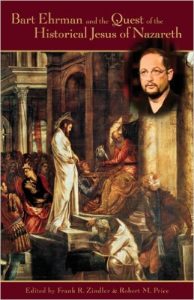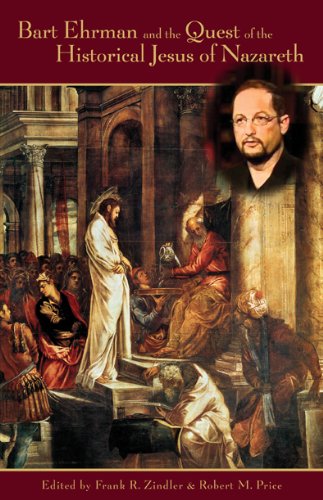H/T Debunking Christianity….
2017-12-12
The UFO of Bethlehem – Through Atheist Eyes with Frank Zindler

Musings on biblical studies, politics, religion, ethics, human nature, tidbits from science

H/T Debunking Christianity….

 When the Ehrman/Price Debate sponsored by Milwaukee Mythicists was opened up to questions from the audience Frank Zindler was the first to speak. He had two questions but the rules allowed him time to only ask one. Much of the audience, so I have heard and as seemed quite apparent to me from the video, was quite taken aback by Bart Ehrman’s hostile dismissal of his first question. Frank asked Bart if he had read the book published in critical response to his Did Jesus Exist? since he had given no indication in the debate that he was aware of its criticisms of the arguments he had just repeated. Ehrman brusquely replied that he had read it, “twice”, but that he disagreed with everything it said and he would not respond.
When the Ehrman/Price Debate sponsored by Milwaukee Mythicists was opened up to questions from the audience Frank Zindler was the first to speak. He had two questions but the rules allowed him time to only ask one. Much of the audience, so I have heard and as seemed quite apparent to me from the video, was quite taken aback by Bart Ehrman’s hostile dismissal of his first question. Frank asked Bart if he had read the book published in critical response to his Did Jesus Exist? since he had given no indication in the debate that he was aware of its criticisms of the arguments he had just repeated. Ehrman brusquely replied that he had read it, “twice”, but that he disagreed with everything it said and he would not respond.
So much for Frank’s first question. Here from Frank Zindler is that second question that he had hoped to ask Bart Ehrman:
Bart, many of us have used your research to support many of our own arguments. For example, in Orthodox Corruption of Scripture you show many examples of anti-Docetic passages in the NT, from the “born-of-woman” Gal 4:4 to the antichrist verses of 1-2 John. Galatians is usually dated to ~54 CE, and if Jesus ever existed, he died in 30 or 33 CE (although Irenaeus claimed he lived into the reign of Claudius, that ended in 54 CE—the very year in which Galatians was written!)
As you know, there are no manuscript variants lacking the born-of-woman gynaikos of Gal 4:4. You have criticized me for claiming interpolation in cases where manuscript evidence is lacking. So……….
According to you own method, the anti-Docetic Gal 4:4 is not an interpolation; it dates to 54 CE if the traditional dating be correct.
So………
If Jesus died in 33 CE, how is it possible that just 21 years later—or even in the very year Galatians was written—there could be widespread forms of Christianity that denied that Jesus had had a body? Was not some form of Docetism therefore the earliest form of Christianity?
Other posts discussing Galatians 4:4 — including from a range of scholarly perspectives — are archived at:

 Many of us are aware of the arguments of Frank Zindler that the John the Baptist passage in Josephus is an interpolation, but we leave those aside here and look at what Rivka Nir of the Open University of Israel offers as reasons for doubting the genuineness of the John the Baptist passage in Antiquities. The following is drawn from “Josephus’ Account of John the Baptist: A Christian Interpolation?” by Rivka Nir in the Journal for the Study of the Historical Jesus (2012) 32-62.
Many of us are aware of the arguments of Frank Zindler that the John the Baptist passage in Josephus is an interpolation, but we leave those aside here and look at what Rivka Nir of the Open University of Israel offers as reasons for doubting the genuineness of the John the Baptist passage in Antiquities. The following is drawn from “Josephus’ Account of John the Baptist: A Christian Interpolation?” by Rivka Nir in the Journal for the Study of the Historical Jesus (2012) 32-62.
Rivka Nir’s article also suggests her own answer to the old question of the origins of the idea of baptism as we read it in connection with John the Baptist.
To begin, let’s refresh our memory of what we read about John the Baptist in Josephus. The translation following is as it appears in Rivka Nir’s article:
(116) But to some of the Jews the destruction of Herod’s army seemed to be divine vengeance, and certainly a just vengeance, for his treatment of John, surnamed the Baptist.
(117) For Herod had put him to death, though he was a good man and had exhorted the Jews who lead [ἐπασκοῦσιν] righteous lives and practice [χρωμένοις] justice [δικαιοσύνῃ] towards their fellows and piety [εὐσεβείᾳ] toward God to join in baptism [be united by baptism] [βαπτισμῷ συνιέναι].
In his view this was a necessary preliminary if baptism [βάπτισιν] was to be acceptable to God. They must not employ it to gain pardon for whatever sins they committed, but as a consecration of the body implying [or: on condition] that the soul was already thoroughly cleansed by [righteousness—R.N.] [δικαιοσύνῃ].
(118) When others too joined the crowds about him, because they were aroused [ἤρθησαν] to the highest degree by his sermons, Herod became alarmed. Eloquence that had so great an effect on mankind might lead to some form of sedition, for it looked as if they would be guided by John in everything that they did. Herod decided therefore that it would be much better to strike first and be rid of him before his work led to an uprising, than to wait for an upheaval, get involved in a difficult situation, and see his mistake. (Antiquities 18.5.2 116-119)
Rivka Nir first gives us the three pillars upon which the authenticity of this passage rests (I omit supporting details in the footnotes and add bold format):
- In view of dissimilarities or even contradictions between the Gospel and Josephus versions about John the Baptist, it is reasoned that had the passage been interpolated by a Christian, the interpolator would most likely have accommodated the account to its version in the Gospels.
- The passage’s correspondence in vocabulary and style to Josephus’ Antiquities in general and books XVII–XIX in particular.
- The presence of the text in all the Josephus manuscripts and its mention by Origen in his Against Celsus (1.47), dated to 248 CE.
1893: Herman Graetz called the passage “a brazen forgery”.(Geschichte der Juden, III, p. 276, n. 3) Continue reading “So John the Baptist was interpolated into Josephus? One more argument for the forgery case”


A while ago I addressed key points in Bart Ehrman’s eagerly awaited response to Christ Mythicism, Did Jesus Exist? and was honoured that Earl Doherty accepted an invitation to post his initial responses to the book here, too. I had much more to say at the time about Ehrman’s efforts but let it all drop since so many others were busy doing the same thing.
I have gradually been getting to know a little more of Frank Zindler’s work since then, and comparing it with what Ehrman himself wrote about it. That, in part, led me to write a defence of Frank’s right to write a chapter about his personal correspondence with Bart Ehrman. A couple of readers disagreed with me on that point, but we will have to agree to disagree. I am still deciding if I will write a post on that chapter about the Zindler-Ehrman correspondence and what it quite fairly tells us.
This evening I revisited the following passage written by Bart Ehrman, but by now I have learned more about Frank’s own arguments. It’s hard to know how to say how I felt without sounding trite. I think it is a good thing not to forget the outrageously unprofessional and scurrilous ways in which Bart Ehrman treated the arguments of mythicists. Those mythicists have every right to reply and defend themselves. That’s not stooping to the level of Ehrman’s unprofessionalism. It’s the right thing to do. If the result is not a stand-alone compendium of mythicist arguments, that’s a loss, but at least we will hear the defence of those Ehrman has so blatantly misrepresented. (Richard Carrier calls Ehrman a liar, a probable liar, or a suspected liar, at least seven times in his chapter.)
Here is what Bart Ehrman wrote about one of Frank Zindler’s points. I will follow this with the quotation from Frank’s own book which Ehrman claimed to be reading and citing.
The [Mithras] cult was centered, Zindler claims, in Tarsus (the hometown of the apostle Paul). But then the astrologers involved with the cult came to realize that the zodiacal age of Mithra was drawing to a close since the equinox was moving into Pisces. And so they “left their cult centers in Phrygia and Cilicia . . . to go to Palestine to see if they could locate not just the King of the Jews but the new Time Lord” (that is, they invented Jesus.* Zindler says this in all sincerity, and so far as I can tell, he really believes it. What evidence does he give for his claim that the Mithraists moved their religion to Palestine to help them find the king of the Jews? None at all. . . . This is made up. (p. 212, DJE?, my highlighting)
The asterisk marks where Ehrman leaves his endnote marker: Zindler, “How Jesus Got A Life”, p. 66
Note that Ehrman distinctly leads his audience to understand that he, Ehrman, is reading Zindler’s argument as published. He implies he knows the context. He is not relying on a couple of decontextualized extracts. He gives the impression that he has read in Zindler’s original words exactly what he has outlined — that the Mithras cult astrologers left their cult centres and moved to Palestine and invented Jesus. Ehrman believes Zindler is arguing that the Mithraic cult moved to Palestine and invented Jesus.
Here is what Frank Zindler actually wrote on page 66. Continue reading “Bart Ehrman and another unprofessional blow at mythicism”

Richard Carrier, PhD, has essentially endorsed Tom Verenna’s “scathing review” of Bart Ehrman and the Quest of the Historical Jesus with one caveat: his complaints “may be a little excessive.” (I discussed earlier the blatant “wrongness” of Verenna’s review.) But we must stress that Verenna had only praise for the contribution from Dr Richard Carrier.
Carrier (with a PhD in ancient history from Columbia University) reinforces Verenna’s ethical discomfort that Frank Zindler chose to publish email correspondence between himself and Ehrman:
Verenna raises some valid concerns worth mulling, such as about Zindler’s use and publication of his correspondence with Ehrman.
Thus even Dr Carrier demonstrates that he is not as thorough in the reading of what he is reviewing as he should be. He, like Verenna, quite overlooked Zindler’s own note at the point of introducing this email exchange:
I thank Professor Ehrman for graciously having granted me permission to reprint here his messages, provided only that I “acknowledge that they were emails, not written intended for publication.”
Because of their careless oversights (accompanied, one must presume, with a lack of interest in seriously checking to see if their grounds for darkening Zindler’s character were real) both have recklessly cast slanderous aspersions upon the integrity of Frank Zindler.
[The nature of the emails and how Frank used them are outlined in a comment below.]
One might wonder about the professionalism of a scholar who publishes a scathing review of a book to which he has contributed and advises his readers they are better off not bothering with it. (Professionalism, in my view, extends to treatment of one’s colleagues as much as it does to how one approaches one’s job.) But Dr Carrier clears the air on this point at the outset of his review. His relationship with the other contributors of this volume, and in particular with its editors, is entirely a business one. He stresses that he sold the rights to his article to them so they could make use of it: Continue reading “Richard Carrier’s Review of Bart Ehrman and the Quest of the Historical Jesus”

Edited with a few additional remarks 4 hours after first posting.
 This post is a response to Book Review: Bart Ehrman and the Quest of the Historical Jesus of Nazareth. I read this review before I received my own (Kindle) copy of Bart Ehrman and the Quest of the Historical Jesus of Nazareth, so I was dismayed when I began to read the book to find that I had been completely misled as to its character and content. Fear that that same review may influence many negatively towards the contributors of the book is what is compelling me to write this response now. (Apologists like McG are quite eager to lap it up uncritically.)
This post is a response to Book Review: Bart Ehrman and the Quest of the Historical Jesus of Nazareth. I read this review before I received my own (Kindle) copy of Bart Ehrman and the Quest of the Historical Jesus of Nazareth, so I was dismayed when I began to read the book to find that I had been completely misled as to its character and content. Fear that that same review may influence many negatively towards the contributors of the book is what is compelling me to write this response now. (Apologists like McG are quite eager to lap it up uncritically.)
The review levels five charges against Bart Ehrman and the Quest of the Historical Jesus of Nazareth:
I’ll address these in reverse order.
I was shocked to read this and feared that Frank Zindler may have overstepped the mark when I read this accusation. So I was particularly keen to read carefully how Frank does introduce these email exchanges with Bart Ehrman. I was greatly relieved to learn that Tom Verenna’s aspersions were entirely misplaced. Here’s what I found. Frank attaches the following note at the point of publishing the first email response from Bart Ehrman:
I thank Professor Ehrman for graciously having granted me permission to reprint here his messages, provided only that I “acknowledge that they were emails, not written intended for publication.”
I do wonder, however, about the ethics of publishing an image of a personal message from Frank to the reviewer. Did T.V. seek F.Z’s permission for this?
Robert M. Price, we are told, “inflates” the credentials of D.M. Murdock/Acharya S. Continue reading “Book Review: Bart Ehrman and the Quest of the Historical Jesus of Nazareth — Reviewing the review”

 Frank Zindler’s Through Atheist Eyes: Scenes From a World That Won’t Reason is a treasure chest of reflections on religion, Christianity in particular. I’m sure he won’t mind if I share a few of them here from time to time.
Frank Zindler’s Through Atheist Eyes: Scenes From a World That Won’t Reason is a treasure chest of reflections on religion, Christianity in particular. I’m sure he won’t mind if I share a few of them here from time to time.
In chapter 15 of volume 1 he captures the essence of a curiosity in the New Testament that seems to generally fly right over the heads of anyone prone to take reputed Holy Writ far too seriously. How often do we hear even professors of religion declaring that the Christ Myth is patently false because the apostle Paul wrote that Jesus had a body! They are usually more specific than that. They’ll say Paul wrote that Jesus was born to a woman! And that Jesus had flesh and blood. There it is! In plain print! Jesus was no myth!
The sorts of passages they’ll usually quote are:
Galatians 4:4-5 But when the set time had fully come, God sent his Son, born of a woman, born under the law,to redeem those under the law
Romans 1:3 concerning his Son, who was descended from David according to the flesh
Romans 8:3 For God has done what the law, weakened by the flesh, could not do. By sending his own Son in the likeness of sinful flesh and for sin, he condemned sin in the flesh,
Colossians 1:21-22 Once you were alienated from God and were enemies in your minds because ofyour evil behavior. But now he has reconciled you by Christ’s physical body through death
1 Timothy 3:16 Great indeed, we confess, is the mystery of godliness: He was manifested in the flesh, vindicated by the Spirit, seen by angels, proclaimed among the nations, believed on in the world, taken up in glory.
1 Peter 3:18 For Christ also suffered once for sins, the righteous for the unrighteous, that he might bring us to God, being put to death in the flesh but made alive in the spirit,
1 Peter 4:1 Since therefore Christ suffered in the flesh, arm yourselves with the same way of thinking, for whoever has suffered in the flesh has ceased from sin,
1 John 4:1-3 Dear friends, do not believe every spirit, but test the spirits to see whether they are from God, because many false prophets have gone out into the world. This is how you can recognize the Spirit of God: Every spirit that acknowledges that Jesus Christ has come in the flesh is from God, but every spirit that does not acknowledge Jesus is not from God. This is the spirit of the antichrist, which you have heard is coming and even now is already in the world.
2 John 1:7 For many deceivers have gone out into the world who do not confess Jesus Christ as coming in the flesh. This is a deceiver and an antichrist.
Frank Zindler delves a little into the consensus dates for these texts and other extra-biblical writings expressing similar thoughts. I’m in the mood for a much simpler post for now so here’s the pertinent point: Continue reading “Did Jesus Have A Body?”


Bart Ehrman has stridently insisted he really did read the mythicist works he reviewed in Did Jesus Exit? (DJE?) so we must take him at his word. And being a scholar we know he is a gentleman and therefore honest, so we must conclude, I think, that he was very tired or unwell and badly losing concentration when he read René Salm’s and Frank Zindler’s writings casting doubt on the existence of Nazareth. I can see little in common between Ehrman’s “representations” of their arguments and their actual works themselves. This post will point to some of the most incomprehensible discrepancies — incomprehensible, that is, IF Ehrman really did read Salm and Zindler with any elementary comprehension and attention.
(Earl Doherty chose not to address this question in his review #23 of Ehrman’s book because it is not a question he as examined and, as Ehrman himself says — p. 197 of DJE? –, whether Nazareth existed or not does not, of itself, decide the question of Jesus’ existence. Earl Doherty’s reviews of Ehrman’s DJE? have been updated, revised and collated as a Kindle e-Book on Amazon.)
Ehrman addresses the argument over the existence of Nazareth in pages 191 to 197 of his book. Curiously, Ehrman says the argument that Nazareth did not exist is “one of the more common claims found in the writings of mythicists” (p. 191).
It is?
It is not found in any of the writings of Earl Doherty nor, from what I have read, in any of the writings of Robert M. Price (though I understand he has made some mention of it on an audio session) or Thomas L. Thompson or Richard Carrier. I think G. A. Wells makes passing mention of it. Ehrman does not help us here because he footnotes not a single source for his claim.
Ehrman writes:
The logic of this argument, which is sometimes advanced with considerable vehemence and force, appears to be that if Christians made up Jesus’s home-town, they probably made him up as well. (p. 191)
I like that weasel-phrase “appears to be” — it is a favourite of James McGrath, too. It means one can always plead that one never made any accusations but only that your stupid words “appeared” to be stupid. Of course, as anyone who has read earlier analyses of Ehrman’s work on this blog would by now expect, Ehrman gives readers no citations, no evidence in support of his accusations. He simply makes them up.
#2 —
I had not even known that Zindler had written anything about Nazareth until I read Ehrman’s response to it. (Zindler’s main “mythicist” publication certainly does not discuss it.) So I looked it up. There is a copy online, Where Jesus Never Walked. Now Zindler’s article is rich with humour. At times he can be downright funny. Is this the trait that Ehrman interprets as diabolical “vehemence and force”?
#3 —
And here is how Zindler expresses the significance of the evidence against Nazareth existing in the time of Jesus. Observe that it is not quite how Ehrman says it “appears to be”: Continue reading “Bart Ehrman’s “unture” claims about the Nazareth arguments”

Frank Zindler’s response to Bart Ehrman is now online, Clarice O’Callighan of the JesusMysteries Forum alerts us. See his online article Bart Ehrman and the Cheshire Cat of Nazareth
His opener:
When all that is left of a Cheshire cat is its grin, how can we be sure it is in fact the grin of a cat? To be sure, if we have watched a grinning cat disappear progressively until all we see is its grin, we can have some confidence that the aerial grin we perceive to remain is in fact that of a cat. As the grin further dissolves into the fog and mist of a perplexing day, however, it becomes harder and harder to determine if the motes that float before our eyes are still the remnants of the grin or just the random rubbish of polluted air. At some point, however, we will have to admit that the cat is gone—completely gone.
This all seems obvious enough and uncontroversial. But what if someone else were to walk by as you were standing at the wayside peering into the low branches of a tree and fixing your gaze on the fading remnants of the grin?
Then there’s this gem:
If Q was a true listing of the wise sayings of Jesus, then Ehrman could probably argue that Jesus had been well educated in Greek literature—including Aesop’s Fables! In fact, Jesus had had such a good Hellenisic education that he even quoted Aesop in one of his sayings that is reported in Q and adapted as Matthew 11:17 and Luke 7:32.
And what must historicists try to do? Continue reading “Frank Zindler’s Response to Bart Ehrman: The Parable of the Cheshire Cat”